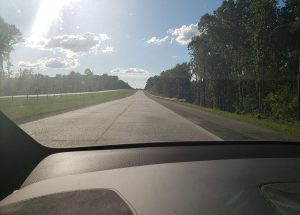The mystery of the disappearing pavement marking
A not so unusual pavement marking phenomenon (as seen in this video) has recently become a hot topic among state DOTs. It’s likely that you have personally witnessed this mysterious occurrence. You are diving down the highway and suddenly the pavement markings seemingly disappear. But the strange thing is, that if you look in the rearview mirror, there they are again, as visible as ever. If this happens, it is likely that you are either east bound as the sun is rising or west bound as the sun is setting. Or you could simply be driving at night with an oncoming vehicle’s high-beam lights on.
In all three instances there is an intense light coming toward the driver at a low angle. That intense light reflects or sort of skips off the marking and the surrounding pavement into the drivers view, impeding them from distinguishing the marking from the pavement.
This phenomenon can occur on all marking types such as tapes, thermoplastics, paints and multi-component materials. It also can occur regardless of the marking’s color, whether white, yellow or even black. Yes even a black line on a light pavement can disappear in these conditions. But the most typical scenario is an east/west roadway with a light colored pavement and white markings.


This phenomenon diminishes both human and machine driven vehicles ability to operate safely. Fortunately for human drivers we can process a multitude of other visual cues such as position of roadside structures and landscape, other cars, edge of pavement, guardrail, signs and such. These cues give us the ability to continue safe navigation in areas of short term impediment. However, even with such cues, if the impediment is extended for any great distance or time, it can put the driver and others in the roadway in great danger.
For vehicles that provide advanced driver assistance systems (ADAS), like the hundreds of models that have lane departure or lane-centering steering systems, it becomes even more hazardous. As these systems do not yet have the ability to adequately process these other visual cues.
Today’s advanced vehicles utilize a bank of systems to operate including radar, ultrasonics and cameras. For lane management and detection, the vehicle primarily depends on the camera system to insure safe navigation. These cameras rely almost exclusively on the roadway markings’ visibility. This visibility is dependent upon the markings’ contrast to the surrounding pavement. Not enough contrast, the camera cannot detect the marking which causes something of ‘computer confusion’, rendering the system impaired and often requiring human intervention.
The combined intensity and angle of the forward light in these conditions eliminate nearly all color contrast. Occasionally, a form of contrast remains and the marking may appear black or even glass or ice-like. But it is not distinguishable as a colored road marking by humans.
Efforts have been made to solve this problem by adding black contrast lines alongside the marking as a countermeasure. This type of contrast treatment can be very effective in normal lighting conditions. But under low angled, intense light, it fails as an acceptable solution. Another countermeasure attempt is the addition of black markings leading or lagging skip lines. This method adds significant installation and maintenance costs with less than satisfactory results. Remember, due to the angle and significant intensity of the light, color contrast alone is not effective in improving visibility of the marking.
We at PPP are dedicated to developing safe, smart, simple solutions for roadway safety risks such as this. With that goal, we examined this phenomenon carefully for such a solution. The result is the development of the LaneAlert TruContrast marking. The TruContrast design disrupts this reflective skip of highly-intense light eliminating its impact in such scenarios. Ensuring that the markings’ color, size and shape remains visible under all lighting conditions, regardless of intensity or angle. We are currently developing ways to deliver this product in various material forms.
If you’d like to be kept informed of this Innovative development be sure to Sign up here for our friends list and specify this product of interest.
Greg Driskell
President, PPP, Inc.
Safe, Smart, Simple Transportation Safety Innovators


